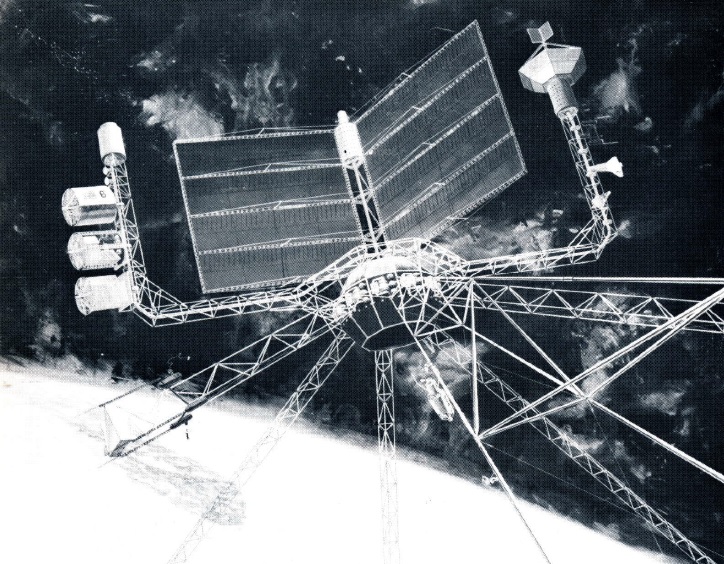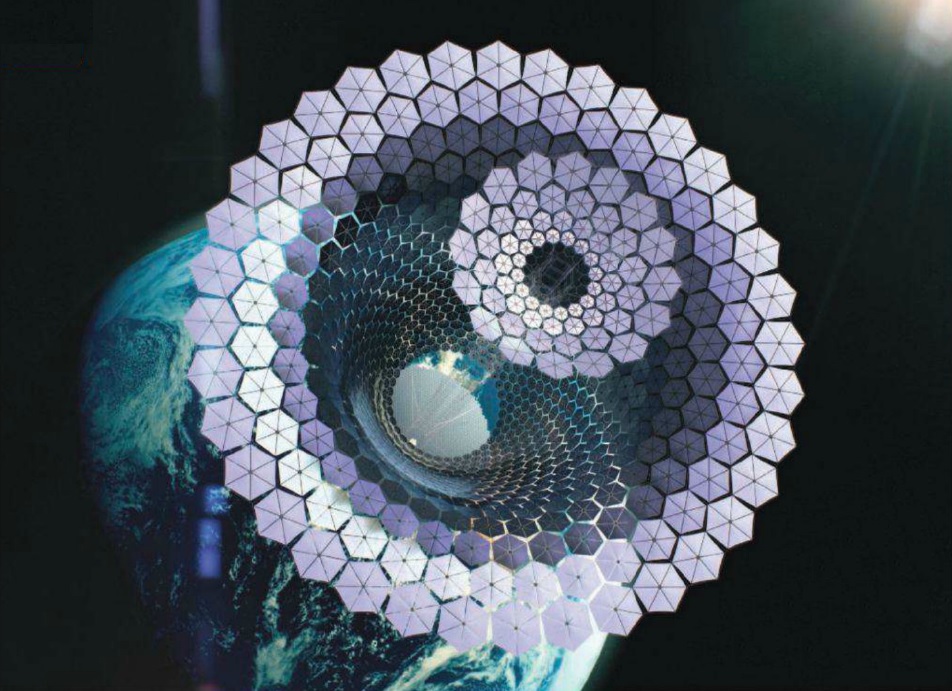|
| |
|
Solar Power Satellites During 1968, the Czech / American scientist Peter Glaser described for the first time a system to reflect solar energy from space to Earth. Via solar panels on a geostationary satellite (a satellite that has an orbital period of one day, and therefore does not move not move with respect to the earth), the collected solar energy would be converted into electricity. This electricity would be sent to a receiving station in the form of radio waves, in order to be fed to the power grid after conversion to electricity. An advantage over solar panels on earth is that the yield in space is much larger; due to the absence of the atmosphere, the intensity of the sunlight is more than 140% of that on earth, moreover in the space nearly 100% of the time solar energy can be converted, while that on earth is about 30%. Time to work out the plans was not there at that moment; Glaser was involved in the development of the Lunar Ranging Retroreflector Array, an instrument that was placed on the moon during the Apollo 11 mission. In 1973, Glaser received a patent on his idea. Incidentally, science fiction writer Isaac Asimov had already written in 1941 about sending solar energy from a space station. |
 The Powersat concept from Boeing from 1975
The Powersat concept from Boeing from 1975
|
Attractive alternative The major disadvantage of the idea described by Glaser was the enormous costs that would be involved in the launch. The solar energy reflector would have dimensions in the order of kilometers, for which numerous rocket launches would be necessary. But with the outbreak of the oil crisis, the application of the Solar Power Satellite, as Glaser called his invention, seemed an attractive alternative. With scarcity and increasing oil prices, costs now played a less prominent role. In 1975, Boeing launched plans for the construction of huge space power plants, based on the principle of Glaser, with the difference that solar collectors would not be used, but of reflection panels. The heat generated by bundling the reflected sunlight would then be converted into electricity by means of "heaters". These heaters operated on the basis of thermal expansion. The power plant could provide 13500 megawatts of energy, but it required a construction with a total weight of 71,000 tons, and reflectors with a total surface of 50 square kilometers! Boeing expected that around 1993 rockets would have sufficient capacity to place the construction in an acceptable number of parts in space. The total cost would be around USD 60 billion, twice as much as the Apollo project, for putting eight power plants into orbit. In 1977, Lockheed received the assignment from NASA for the development of basic components (pipe elements and connectors) for the construction of large structures in space. Eventually those elements would even have to be built in space. The project was led by the legendary Robert R. Johnson, who also saw the building of power plants as an application for the components. Rockets did not develop in the direction that Boeing had anticipated: they became much more efficient, while the capacity certainly did not increase. It is therefore not surprising that the plans for the space power plants remained on the drawing boards, although in 1986 and late 90s, NASA still conducted studies on the state of the technology and costs involved. |
 Another concept by Boeing from 1978: a 24 km long system
Another concept by Boeing from 1978: a 24 km long system
|
| Various new initiatives Peter Glaser died on May 29, 2014, just when the Solar Power Satellite again gained interest, now mainly driven by the increasing need for energy. David Hyland, a professor at the Texas A & M University, started the procedure for obtaining a patent on what he calls the Power Star; actually a hybrid between the idea of Glaser and the Echo satellite from the early 60s. The Echo satellite was a reflective inflatable balloon, which was brought into orbit around the earth to reflect communication signals. The Power Star consists of such a balloon, the envelope being provided with printed photovoltaic cells. The energy transformed into radio waves (for which the instrumentation was located in the balloon) was first sent to the surface inside the balloon, and then, via transmitters (also arranged on the balloon surface), sent to the ground station. According to Hyland, a balloon with a diameter of 1 km, based on an efficiency of 2% for the conversion and transmission process, could provide 3 to 4 megawatts of power (which is approximately equal to the maximum capacity of a modern wind turbine). With increasing efficiency and improvement of the printed photovoltaic cells, this can increase to 50 megawatts in the future. In both China and Japan, more extensive work is being done on Solar Power Satellites. The Japanese space agency JAXA has bringing power plants into space as one of the targets for the coming decades. JAXA has determined that for a geostationary 10000 ton power plant, which can supply 1 gigawatt of energy, the energy costs will be about 1.12 USD / kWh. The launch costs are 10000 USD per kg, for transport to a low orbit around the earth. After assembling the power plant in space, the construction can relatively inexpensive being brought into geostationary orbit. However, with these costs, Solar Power Satellites will never be able to compete with energy generated on Earth. But, with the introduction of especially commercial missiles, such as the SpaceX Falcon 9, launch costs will greatly reduce. SpaceX states that these can go to 1000 USD / kg, the energy price of a Solar Power Satellite would then be 0.18 USD / kWh, which is equal to the current price of "terrestrial" electricity. An interesting idea that could ensure that Solar Power Satellites actually get off the ground has been suggested by the American Atemis Innovations, an agency of former NASA scientist John Mankins. His SPS-Alpha is based on a modular structure that starts on a small scale. Initially, the generated energy is not sent to earth, but to telecommunication satellites that can therefore deliver much higher performance. With a relatively small Solar Power Satellite, the costs would be immediately reduced and valuable experience with the technology would be gained. Aboard the USAF X-37B Orbital Test Vehicle, that was launched May 17, 2020, is a US Naval Research Laboratory module that converts sunlight for microwave power transmission. This concerns the first in orbit hardware designed specifically for solar power satellites. The experiment focuses on the energy conversion process and resulting thermal performance. |
 The modern SPS-Alpha concept: modular construction
The modern SPS-Alpha concept: modular construction
|
| Sources - Frank Morring - Waiting Market - Aviation Week and Space Technology, April 21, 2014 - Frank Morring - Sun Power - Aviation Week and Space Technology, June 9, 2014 - Mark Williamson - A modern take on an old idea - Aerospace America November 2014 - Avia - maandblad voor luchtvaart en ruimtevaart (in Dutch): September 1975, December 1977, May 1978 |